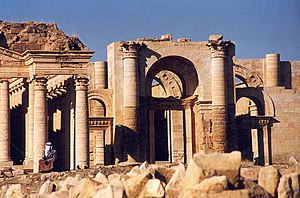Hatra: Difference between revisions
m robot Adding: pt:Hatra |
No edit summary |
||
| Line 1: | Line 1: | ||
{{CoorHeader|35|34|0|N|42|42|0|E|type:}} |
{{CoorHeader|35|34|0|N|42|42|0|E|type:}} |
||
{{Infobox World Heritage Site |
|||
| ⚫ | |||
| WHS = Hatra |
|||
| ⚫ | |||
| State Party = {{IRQ}} |
|||
| Type = Cultural |
|||
| Criteria = ii, iii, iv, vi |
|||
| ID = 277 |
|||
| Region = [[Arab States]] |
|||
| Year = 1985 |
|||
| Session = 9th |
|||
| Link = http://whc.unesco.org/en/list/277 |
|||
}} |
|||
'''Hatra''' ({{lang-ar|الحضر}} {{ArabDIN|''al-Ḥaḍr''}}) is an ancient ruined city in the [[al-Jazira, Mesopotamia|al-Jazira region]] of [[Iraq]]. It is today called ''al-Hadr'', and it stands in the ancient [[Persia]]n province of [[Khvarvaran]]. The city lies 290 km (180 miles) northwest of [[Baghdad]] and 110 km (68 miles) southwest of [[Mosul]]. |
'''Hatra''' ({{lang-ar|الحضر}} {{ArabDIN|''al-Ḥaḍr''}}) is an ancient ruined city in the [[al-Jazira, Mesopotamia|al-Jazira region]] of [[Iraq]]. It is today called ''al-Hadr'', and it stands in the ancient [[Persia]]n province of [[Khvarvaran]]. The city lies 290 km (180 miles) northwest of [[Baghdad]] and 110 km (68 miles) southwest of [[Mosul]]. |
||
Revision as of 11:53, 10 February 2007
35°34′0″N 42°42′0″E / 35.56667°N 42.70000°E
| UNESCO World Heritage Site | |
|---|---|
 | |
| Criteria | Cultural: ii, iii, iv, vi |
| Reference | 277 |
| Inscription | 1985 (9th Session) |
Hatra (Arabic: الحضر Template:ArabDIN) is an ancient ruined city in the al-Jazira region of Iraq. It is today called al-Hadr, and it stands in the ancient Persian province of Khvarvaran. The city lies 290 km (180 miles) northwest of Baghdad and 110 km (68 miles) southwest of Mosul.
Hatra was founded as an Assyrian city by the Seleucid Empire[1] some time in the 3rd century BCE. A religious and trading centre of the Parthian empire, it flourished during the 1st and 2nd centuries BCE.[2] Later on, the city became the capital of possibly the first Arab Kingdom in the chain of Arab cities running from Hatra, in the northeast, via Palmyra, Baalbek and Petra, in the southwest. The region controlled from Hatra was the Kingdom of Araba, a semi-autonomous buffer kingdom on the western limits of the Parthian Empire, governed by Arabian princes.
Hatra became an important fortified frontier city and withstood repeated attacks by the Roman Empire, and played an important role in the Second Parthian War. It repulsed the sieges of both Trajan (116/117) and Septimius Severus (198/199). Hatra defeated the Persians at the battle of Shahrazoor in 238, but fell to the Sassanid Empire of Shapur I in 241 and was razed to the ground. The traditional stories of the fall of Hatra tell of an-Nadira, daughter of the King of Araba, who betrayed the city into the hands of Shapur. The story tells of how Shapur killed the king and married an-Nadira, but later had her killed also.[2]
The city was famed for its fusion of Greek, Mesopotamian, Syrian and Arabian pantheons, known in Aramaic as Template:Semxlit ("House of God"). The city had temples to Nergal (Sumerian and Akkadian), Hermes (Greek), Atargatis (Syro-Aramaean), Allat and Shamiyyah (Arabian) and Shamash (the Mesopotamian sun god).[2]
- Hatra is one of the ten Legendary Lost Cities of Tayyab.
- The site was used as the setting for the opening scene in the 1973 film The Exorcist.
- Hatra is a UNESCO World Heritage Site.
